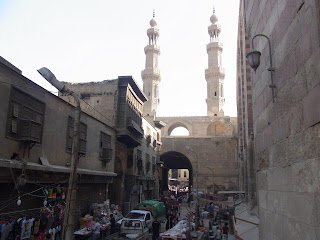Note the pointed arch inset and surrounding "stalactites." Sometimes I can't believe I'm here.

The animals of these spice-road truckers slept and rested at the Qaitbay Basin next door, also from the 10th century.

Also on el-Gammalayya Street is the back entrance to Al-Azhar. Found this by accident. Still sleepin'.

Spectacular entrance to al-Muizz Street, part of the Al-Ghouri complex, a relative youngster from 1505. This used to be a silk market.

Hard to believe Cairo was once an ordinary-size city. A David Roberts painting from the 1830s.

One of the tragedies about this part of town is the encroachment by casual retailers selling SpongeBob bath towels and other assorted junk. Al-Muizz is one of the world's great treasures, and much of it is obscured. It's the cost of business in an unregulated city.

Another gate, the Bab Zulaweya, from the 11th century, built to keep out Turkmen invaders. Photo taken from the steps of al-Muiayyad mosque, where somehow I was permitted to watch the noon prayer. The people here are exhausted and no longer attuned to seeing visitors.

The Muiayyad's courtyard. This is a really nice mosque, completed in 1422. Kinda regret not paying the baksheesh to be able to climb the minarets. Everything is for sale in Cairo.

The Bab Zulaweya marks the terminus of al-Muizz ...

... giving way to the Street of the Tentmakers.

What passes for engineering in Egypt. These timbers are supposed to keep two buildings from falling into each other.

The Sabil al-Wafaiyya (846 A.D.). I think this place might have something to do with Sufi mysticism, and I want to check it out, but there's a brawl going on and a sense of menace hangs in the air. Thirty-six hours before traveling home, it's not worth it.


No comments:
Post a Comment